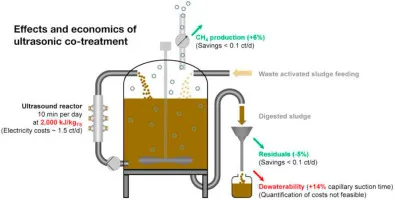The present study assessed the performance of ultrasonic co-treatment, i.e., the treatment of digested sewage sludge in continuously operated anaerobic digesters. Experiments were carried out using a non-sonicated control digester and a sonicated test digester. The test digester received side-stream sonication (∼10% of reactor volume per day) at a specific energy input of 2,000 kJ/kgTS. Treatment effects were monitored based on (i) specific methane production, (ii) (volatile) solids removal, and (iii) digestate dewaterability. Results revealed that co-treatment significantly enhanced average methane production (+6%), volatile solids removal (+9%), and solids reduction in the digestate (−5%). However, due to the only moderate enhancement and the relatively high energy input, the average cost recovery (i.e., the ratio between electricity costs and benefits due to additional methane and improved solids removal) was only 6%–9%, depending on the assumed disposal costs. Moreover, as sonication led to impaired digestate dewaterability (average increase in normalized capillary suction time of 14%), the cost recovery due to reduced residual sludge might be negated again by lower dewatering efficiency. Overall, co-treatment seemed not economical under the conditions investigated. To render co-treatments economically feasible, further research, especially exploring the potential of low energy input sonication, is required.
Lippert et al. 2020
Neuer Zeitschriftenbeitrag von Lippert et al. 2020
